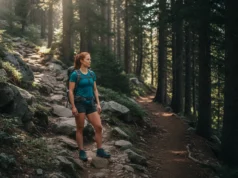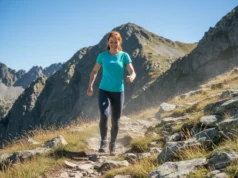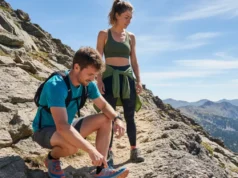In this article
The modern adventure doesn’t always end at the trailhead. Sometimes it flows directly to the post-hike brewery, the airport gate, or a casual dinner with friends. For years, hikers were stuck with a false choice: the clunky, overbuilt hiking boot of the past that felt out of place anywhere but the deep woods, or flimsy running shoes that simply wouldn’t cut it on technical terrain. This is the new challenge for today’s active adventurer: finding cool hiking shoes that deliver rugged trail performance without sacrificing the style and versatility your life demands. This guide, filled with in-depth reviews, is your roadmap to navigating that intersection. We’re moving beyond the spec sheets and marketing hype to find a piece of hiking footwear that truly fits your feet and your lifestyle.
This isn’t just about looking good. It’s about getting more value and utility from your outdoor gear. We’ll help you understand the core trade-offs you need to make, balancing critical performance factors like traction, comfort, and weather resistance with the equally important metrics of weight and style. To do this, we’ve defined three key hiker personas—The Trail-to-Tavern Weekender, The Fast-and-Light Purist, and The Rugged Traditionalist—to help you pinpoint a shoe that aligns with your specific needs, whether for day hiking or ultralight backpacking. By the end, you’ll be able to shop with confidence, armed with our rigorously field-tested top hiking shoes for 2025 and a transparent evaluation framework that empowers you to see past the marketing and make a truly informed decision.
How to Choose the Right Cool Hiking Shoes: An Expert’s Framework
As an instructor who has seen countless students show up with the “wrong” shoes, I can tell you that making a smart choice here is the single most important gear decision you’ll make. It’s not about brand names; it’s about understanding the engineering under your feet. This framework turns technical jargon into tangible benefits so you can make a confident, expert-level choice for the best hiking shoes to fit your needs, from casual hikers to dedicated thru-hikers.
Why is Comfort & Cushioning About More Than Just a Soft Feel?
True comfort on the trail isn’t about that initial “ahh” moment you get when you slip on a shoe in the store. It’s about long-term endurance and all-day comfort. It’s about finishing an eight-mile hike without feeling every sharp rock and having the energy to do it again tomorrow. The real engine of shock absorption is the midsole, typically made of EVA or polyurethane, which creates a responsive midsole feel. EVA is lighter and offers more plush cushioning, like you’d find in lightweight trail runners, while polyurethane is firmer and more durable, common in traditional hiking boots. This leads to a critical trade-off: “maximalist” shoes with thick cushioning protect your joints but can numb your “ground feel,” which is your foot’s ability to sense and react to the terrain. Less cushion means more ground feel, giving you better stability and responsiveness on technical rock. But don’t forget the other touchpoints. A well-padded tongue and ankle collar, along with a supportive insole, are what prevent pressure points and the dreaded hotspots that can lead to a miserable day. True shoe comfort is a system working together for the long haul, preventing blisters and hotspots from the first mile to the last.
But even the most comfortable hiking shoes are useless if they can’t keep you upright on the trail.
How Do Traction & Grip Keep You Safe on Any Surface?
Traction is your insurance policy against a slip-and-fall injury. I’ve seen overconfidence turn into a sprained ankle in a split second on a patch of wet terrain. Grip isn’t just one thing; it’s a function of two key elements: the rubber compound and the lug pattern of the outsole type. You’ll see names like Vibram Megagrip and Salomon’s Contagrip thrown around, and for good reason—these are gold-standard sticky rubber compounds that grab onto rock like a gecko. The pattern of the lugs is just as crucial. Deep, widely-spaced, aggressive lugs are designed to shed mud and dig into soft ground, while broader, shallower lugs provide more surface area for gripping desert slickrock. A critical but often overlooked feature is the “heel brake”—a distinct, sharp-edged pattern on the heel that helps you control your speed on steep, sketchy descents. There’s a trade-off here, too. Stickier rubber provides phenomenal grip but wears down faster, while harder rubber compounds last longer but offer less purchase on wet surfaces. The best shoes find a balance, giving you superior traction from outsoles you can trust.
Once your footing is secure, the next job is to ensure your foot is secure inside the shoe.
What’s the Difference Between Support & Stability?
People often think support comes from a high-ankle boot, but that’s a misconception. True support and stability come from the shoe’s internal “chassis,” which resists unwanted twisting and flexing on uneven ground. Think of it as the frame of a car. Key components include internal shanks, which are semi-rigid plates that provide arch rigidity and reduce foot fatigue, and a protective rock plate, a thin, flexible insert that shields the bottom of your foot from sharp rocks and roots. This is where Hiking shoes provide greater stability than their more flexible trail-running cousins. A stiffer, more structured shoe offers incredible support on rocky, off-camber terrain, but it can feel restrictive and clunky on flat, well-groomed trails. The shoe’s platform also plays a role; a wider base is inherently more stable, while a high stack height can sometimes feel wobbly if not designed properly.
Pro-Tip: To test a shoe’s torsional rigidity, hold it by the heel and toe and try to twist it like you’re wringing out a towel. A supportive hiking shoe will resist this twisting motion significantly more than a flimsy sneaker.
A supportive chassis is only as good as the materials it’s built from.
How Do You Balance Durability, Weight & Breathability?
The holy grail of shoe design is finding the perfect balance between these three competing factors. Durability is a direct result of the upper material and construction quality. Traditional full-grain leather hiking shoes are bombproof and will mold to your foot over time, but they’re heavy, require a long break-in period, and have low breathability. Modern synthetic hiking shoes with engineered mesh uppers are incredibly lightweight and breathable right out of the box, but they are far more susceptible to abrasion and tears. Look for reinforcements like rubber toe caps and full-wrap rands, which are strips of rubber that protect the lower part of the shoe from scuffs. The biggest trade-off comes with a waterproof hiking shoe using proprietary membranes like GORE-TEX (GTX). They are fantastic for keeping your feet dry from the outside, but they dramatically reduce breathability. For many hikers, the question of Are Waterproof Hiking Shoes Worth It? is a critical one. Ultimately, you must accept that the lightest hiking shoe almost always compromises on durability and support. It’s a classic “pick two” scenario.
Pro-Tip: For hot, dry climates or if you have sweaty feet, consider non-waterproof footwear. They breathe significantly better, and if they do get wet from a stream crossing, they dry out much faster than a shoe with a waterproof membrane.
This brings us to the final, and perhaps most defining, element of a “cool” hiking shoe.
Why Does Style & Versatility Matter for a Hiking Shoe?
In the past, this was a non-issue. Hiking boots were ugly, and that was that. Today, style and versatility have become a major driver in the shoe market. This is the “trail-to-town” capability—a shoe that performs flawlessly on a dusty mountain trail but also looks appropriate and stylish in a casual, social setting. This isn’t just about vanity; it’s a practical consideration for outdoor recreation. For travelers, minimalists, and lifestyle-oriented users, having one shoe that can do it all means packing lighter and getting more value from a single piece of gear. This trend is driven by consumer demand for better aesthetic style, and footwear brands have responded with minimalist shoes, heritage-inspired looks, and unique, modern colorway options. Think of it not as a compromise, but as an added feature that extends the life and usefulness of your investment far beyond the trailhead.
Now that you’re armed with the knowledge to judge any shoe like a pro, let’s show you how we applied this framework to our top shoe picks.
Our Selection Process: How We Built This Guide
We believe that trust is earned through transparency. This guide isn’t just a list of shoes we like; it’s a data-driven resource based on hands-on testing, designed to empower your decision, not make it for you. Our goal is to help you find the shoe that is perfect for your specific needs, and we take that responsibility seriously.
Every single one of these great hiking shoes was rigorously analyzed against the six core performance criteria—Comfort, Traction, Support, Durability, Weight, and Style—and the key specifications we detailed above. This ensures that every rating, from comfort rating to durability rating, is consistent, defensible, and directly comparable across different models. Our process began with a deep market analysis of dozens of the most popular and promising shoes available, including a shoe comparison of models like the popular Merrell Moab 3 and the durable La Sportiva Spire GTX. We then filtered that long list through our evaluation framework, cross-referencing our own field experience with expert reviews and thousands of real-world customer reviews to identify the undisputed top performers for distinct hiker personas.
Finally, a quick note on how we keep the lights on. If you choose to buy a product through one of our links, we may earn a small commission at no extra cost to you. This financial support is what allows us to conduct our independent testing and in-depth research. We are fiercely committed to our objectivity and only recommend gear we genuinely believe in and would use ourselves.
The Best Cool Hiking Shoes of 2025: Our Top Recommendations for Every Hiker
Our Top Picks for “The Trail-to-Tavern Weekender”
You value a seamless blend of on-trail performance and off-trail style. Your adventures are often spontaneous—a day hike that turns into a brewery visit, a weekend trip where one pair of shoes has to do it all. You need a single, versatile shoe that is as comfortable on a dirt path as it is on a city sidewalk, without ever looking out of place. These are some of the most stylish hiking shoes available.
Our Top Picks for “The Fast-and-Light Purist”
You measure hikes in miles per hour, not just miles. For you, efficiency, minimalism, and covering ground quickly on fast missions are the name of the game. Weight is the enemy, and you prioritize a high degree of cushioning to protect your joints during high-mileage days. Breathability is king, because you know that a waterproof membrane just means a sweat-soaked foot when you’re moving fast, making non-GTX lightweight trail runners your go-to fast-and-light footwear.
Our Top Picks for “The Rugged Traditionalist”
You see your specific footwear as a critical piece of safety equipment. Your hikes often involve challenging, off-camber terrain, questionable weather, and sometimes, a heavy backpack. For you, maximum protection, uncompromising support, and long-term durability are non-negotiable. You’re willing to accept a bit more weight and a longer break-in period in exchange for a capable shoe that inspires absolute confidence when the trail gets tough.
Conclusion
Choosing the right cool hiking shoe ultimately comes down to a personal balancing act. You have to weigh essential trail performance like traction, support, and durability against the demands of a modern, active life where style, versatility, and low weight are just as important. The best hiking shoe is entirely dependent on who you are as a hiker. A style-conscious hiker has vastly different needs from a fast-and-light purist or a rugged traditionalist. Don’t be fooled by marketing claims; understand the core trade-offs. Waterproofing always costs you breathability, more cushion reduces your feel for the trail, and shaving weight almost always means sacrificing durability. Above all, remember that fit notes are paramount. Even the most perfectly rated shoe in the world will ruin your hike if it doesn’t match the unique shape of your foot.
Choosing the right gear is the first step in any great adventure. Now that you’re armed with this framework, what’s your top pick, or do you have a favorite hiking shoe that didn’t make our list? Share your thoughts and questions in the comments below!
Frequently Asked Questions about Hiking Shoes
Are waterproof hiking shoes always the better choice?
No, waterproof hiking shoes are definitely not always the better choice and they involve a significant trade-off. While the best waterproof hiking shoes with a membrane like GORE-TEX are ideal for cool, wet, or muddy conditions, they drastically reduce breathability. This can cause hot, sweaty, and uncomfortable feet in warm, dry climates. For warm-weather hiking, a more breathable, non-waterproof shoe like the Altra Lone Peak 9 will often keep your feet more comfortable and will dry out much faster if it does get wet from a stream crossing.
Can I use trail running shoes for backpacking?
Absolutely, and it’s an increasingly popular choice, especially among long-distance and ultralight hikers. Trail running shoes like the HOKA Speedgoat 6 or Saucony Peregrine 15 are significantly lighter than traditional hiking shoes, which reduces fatigue over long miles. However, they are less durable and offer less support and stability under the stress of a heavy backpack. For carrying heavier loads or on very technical terrain, a more supportive hiking shoe like the Salomon X Ultra 5 GTX is a safer bet.
What is heel-to-toe drop and why does it matter?
Heel-to-toe drop is the height difference between the heel and the forefoot of the shoe, and it can significantly affect your body’s biomechanics. A high drop (8mm or more), common in traditional shoes like the KEEN Targhee IV, is similar to most everyday shoes and can help reduce strain on the calves and Achilles tendon. A low or zero-drop shoe, like the Altra Lone Peak 9, puts your foot in a more natural, flat position. This promotes a midfoot strike but requires an adaptation period for your lower leg muscles to get used to the different load.
What makes a shoe stylish enough for “trail-to-town”?
A great “trail-to-town” shoe masterfully blends technical performance with a versatile, non-bulky aesthetic that doesn’t scream “I just got off the mountain” when you walk into a restaurant. It’s about a cleaner, more streamlined silhouette, thoughtful colorways that avoid loud neons, and the use of premium materials like suede or high-quality textiles. Models like the Danner Trail 2650 GTX excel at this, looking just as good on a city street as they do on a mountain trail, giving you maximum value from your gear.
Risk Disclaimer: Hiking, trekking, backpacking, and all related outdoor activities involve inherent risks which may result in serious injury, illness, or death. The information provided on The Hiking Tribe is for educational and informational purposes only. While we strive for accuracy, information on trails, gear, techniques, and safety is not a substitute for your own best judgment and thorough preparation. Trail conditions, weather, and other environmental factors change rapidly and may differ from what is described on this site. Always check with official sources like park services for the most current alerts and conditions. Never undertake a hike beyond your abilities and always be prepared for the unexpected. By using this website, you agree that you are solely responsible for your own safety. Any reliance you place on our content is strictly at your own risk, and you assume all liability for your actions and decisions in the outdoors. The Hiking Tribe and its authors will not be held liable for any injury, damage, or loss sustained in connection with the use of the information herein.
Affiliate Disclosure: We are a participant in the Amazon Services LLC Associates Program, an affiliate advertising program designed to provide a means for us to earn advertising fees by advertising and linking to Amazon.com. As an Amazon Associate, we earn from qualifying purchases. We also participate in other affiliate programs and may receive a commission on products purchased through our links, at no extra cost to you. Additional terms are found in the terms of service.





